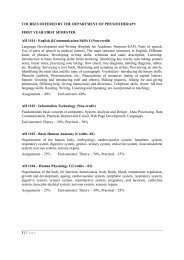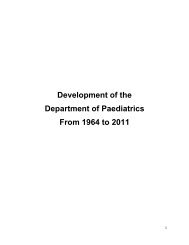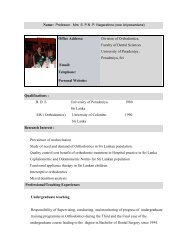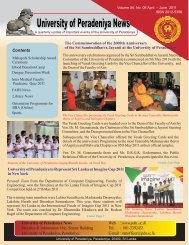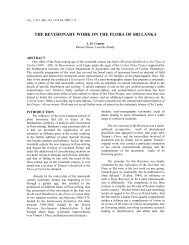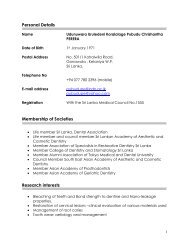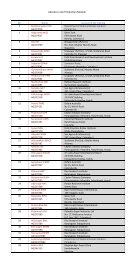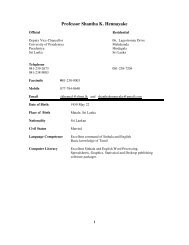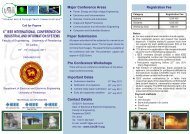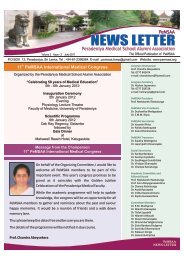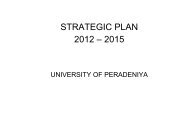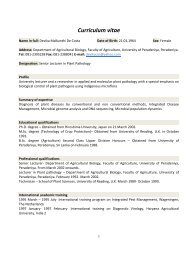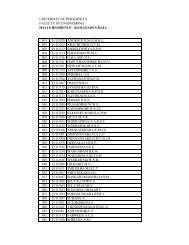PRESENT STATUS OF THE SHRIMP TRAWL FISHERY IN THE ...
PRESENT STATUS OF THE SHRIMP TRAWL FISHERY IN THE ...
PRESENT STATUS OF THE SHRIMP TRAWL FISHERY IN THE ...
You also want an ePaper? Increase the reach of your titles
YUMPU automatically turns print PDFs into web optimized ePapers that Google loves.
Cey. J. Sci. (Bio. Sci.) Vol.32, 2004, 21-37<br />
<strong>PRESENT</strong> <strong>STATUS</strong> <strong>OF</strong> <strong>THE</strong> <strong>SHRIMP</strong> <strong>TRAWL</strong> <strong>FISHERY</strong> <strong>IN</strong> <strong>THE</strong> SEAS<br />
<strong>OF</strong>F NEGOMBO AND HENDALA ON <strong>THE</strong> WESTERN COASTAL<br />
WATERS <strong>OF</strong> SRI LANKA<br />
*P. A. A. T. Jayawardane 1 , D. S. McLusky 2 and P. Tytler 2<br />
1 Marine Biological Resources Division, National Aquatic Resources Research and Development<br />
Agency, Crow Island, Mattakkuliya, Colombo 15, Sri Lanka.<br />
2<br />
Department of Biological Sciences, University of Stirling, Stirling FK9 4LA, Scotland, United<br />
Kingdom.<br />
ABSTRACT<br />
A study was conducted to evaluate the shrimp trawl fishery in the seas off Negombo and Hendala<br />
during the period January 1998 to December 1999. In the shallow seas off west coast trawling is<br />
conducted by two types of crafts viz. 3.5 t wooden boats (mechanised trawls) and traditional sail driven<br />
large dug out canoes (non-mechanised trawls). The total catch effort and the catch per unit effort showed<br />
seasonal variations. A seasonality in the trawl fishery was observed with a peak period from June/July to<br />
October/November, which apparently coincided with the south west monsoon and the inter monsoon<br />
periods of the island. The statistical analysis indicated that the catch rates of both craft types observed<br />
during the south west monsoon were significantly higher than during north east and inter monsoon<br />
periods (P
22 P. A. A. T. Jayawardane et al.<br />
In recent times (1992) shrimp trawling in the seas<br />
off Chilaw was banned as a result of a dispute<br />
between the two fishing communities (traditional<br />
and trawl fishermen) sharing the same resource.<br />
Therefore, shrimp trawling is now restricted to<br />
Negombo and Hendala, in the western coastal<br />
waters of Sri Lanka. In addition trawling is the<br />
major fishing activity taking place in the shallow<br />
coastal waters off Negombo and Hendala,<br />
exploiting the parent stock of shrimps, which<br />
utilise Negombo lagoon for completion of the<br />
early phase of their complex life cycle.<br />
During the present study the aspects of<br />
the trawl fishery studied include monthly<br />
variation in the fishing effort, catch rates, total<br />
catch, species composition and economy of the<br />
fishery. Also included are descriptions of type the<br />
of fishing crafts, gear and area of operation.<br />
MATERIALS AND METHODS<br />
Collection of statistics on catch and effort<br />
A pilot survey was first conducted (along<br />
the coastal stretch between Colombo to<br />
Vennappuwa in the west coast) in order to gather<br />
basic information on the shrimp trawl fishing<br />
activities in the seas off west coast of Sri Lanka.<br />
Based on this information, a rigorous sampling<br />
scheme was formulated. For the collection of<br />
catch and effort data from the trawl fishery, 2<br />
sampling sites were selected from a total of 4 fish<br />
landing sites scattered throughout the study area<br />
(Fig. 1). Pilot survey indicated that around 70% of<br />
the shrimp trawlers engaged in the seas off<br />
Negombo and Hendala unload their catches at the<br />
selected sampling stations. Data collection was<br />
conducted by making regular weekly field visits<br />
to the selected sampling sites during the period<br />
January 1998 to December 1999. Catch and effort<br />
data of the trawl fishery were collected separately<br />
from randomly selected crafts at each sampling<br />
site.<br />
On each sampling day more than 30% of<br />
the total number of fishing crafts that operated at<br />
each sampling site were sampled randomly. The<br />
information on specifications of the craft and<br />
gear, details on fishing operations, the total catch<br />
and its species composition and information on<br />
the economics of the fishery was recorded. The<br />
total number of fishing craft operated at each<br />
sampling site was recorded in order to estimate<br />
the total effort for the particular month. The<br />
number of fishing days for each month was noted<br />
for each craft type.<br />
On each sampling day around 2-3<br />
representative shrimp samples (amounting to 10<br />
to 20% of the total shrimp catch) were collected<br />
at sampling stations and in the laboratory shrimps<br />
were sorted in to species and sexed. The total<br />
length of each specimen (from the tip of the<br />
rostrum to the tip of the telson) was measured to<br />
the nearest 0.1 cm using a measuring board and<br />
the weight of the entire sample was determined.<br />
These were then pooled to estimate the monthly<br />
length frequency data. Finally the monthly length<br />
frequency data were pooled together to estimate<br />
the annual length frequency distributions of major<br />
shrimp species exploited by two types of trawlers.<br />
Measurement of potential climatic factors<br />
influencing the catch rates of the shrimp trawl<br />
fishery such as average wind speed and the<br />
resultant wind direction of the study area, were<br />
obtained from the Meteorological Department of<br />
Sri Lanka. The information on wind speed and<br />
wind direction was used to predict the two<br />
monsoon seasons of the island; the south west and<br />
north east monsoon.<br />
Information on the nature and the area of<br />
fishing operations was also collected during the<br />
study.<br />
Analysis of statistics on catch and effort<br />
Fishing effort and the catch per unit effort<br />
The fishing effort is expressed as the<br />
mean number of fishing crafts operated per day<br />
with respect to each craft type. The mean catch, in<br />
kg per craft-day, was considered as the catch per<br />
unit effort with respect to each craft type based on<br />
the following observations. During the study<br />
period every fishing craft conducted<br />
approximately the same number of hauls<br />
(frequently 4 - 6) and the true fishing time is<br />
almost constant throughout the study period for<br />
each craft type. The number of fishermen<br />
involved in fishing operation is also constant (4)<br />
and they usually have only one fishing operation<br />
per day.
Shrimp trawl fishery in the west coast of Sri Lanka 23<br />
The impact of different factors such as<br />
fishing season and the fishing area on the shrimp<br />
yields from two craft types was evaluated using<br />
the General Linear Model.<br />
The monthly production was estimated<br />
using the following formula: MTP = CPUE x<br />
NFC x MFD where MTP = monthly total<br />
production, CPUE = mean catch in kg per craftday,<br />
NFC = mean number of fishing crafts<br />
operated per day and MFD = mean number of<br />
fishing days for that particular month.<br />
Species abundance and species composition of<br />
the catches<br />
Almost all the finfish and crustacea from<br />
the trawl catches were identified using the FAO<br />
species identification sheets (Fischer and Bianchi,<br />
1984). The species composition of the monthly<br />
catches was also analysed to study the variation<br />
pattern. These values were tabulated as the<br />
percentage of the total catch.<br />
RESULTS<br />
Fishing crafts, gear and operation<br />
In the shallow seas off Hendala and<br />
Negombo trawling is conducted by 3.5 t wooden<br />
boats (mechanised trawls) and traditional sail<br />
driven large dug out canoes (non-mechanised<br />
trawls) respectively.<br />
The use of non-mechanised trawls occurs<br />
outside the lagoon, to a distance of around 10-15<br />
km north of the entrance. They are operated<br />
during daytime in waters up to 12 m depth, from<br />
craft of traditional design (12 m in length), fitted<br />
with outrigger and sail. The nets are towed under<br />
sail power, although when there is insufficient<br />
wind the crew is required to row. The net used is<br />
long narrow and cone shaped, with a small codend<br />
about 1 m in length and a larger body of<br />
about 7 m. The width of the opening of the net<br />
was around 5.64 m. Mesh sizes of the cod end and<br />
the body of the trawl net were 15 and 20 mm<br />
respectively. No floats are used for the head rope.<br />
There are lead sinkers placed at intervals along<br />
the foot rope, and heavy stones of 30-35 kg<br />
attached at each end. The net on each side is<br />
connected to the towing ropes by bridles, of about<br />
4.5 m, to the stones and a shorter length to the<br />
head rope. The towing of a net takes about one<br />
hour at a mean speed of 1.7 km hr -1 (SD = 0.18)<br />
and then it is manually hauled. The direction of<br />
the craft is then reversed and the net returned to<br />
the water. There are around 4-6 hauls during a<br />
fishing day and the mean true fishing time was<br />
estimated at 5.23 hours (SD = 1.88).<br />
The mechanised trawls are operated from<br />
the Hamilton canal (Fig. 1) on grounds located<br />
about 15-20 km south of the entrance to Negombo<br />
lagoon. They are prohibited by regulations from<br />
fishing on the same grounds as non-mechanised<br />
trawlers. The crafts are of the 3.5 t type, 10.4 m in<br />
length, and of modern design. They are powered<br />
by inboard diesel engines of 25-40 HP. Thick<br />
bamboo poles are extended as booms either side<br />
of the craft from which the net is towed. The<br />
fishing operations and net design are otherwise<br />
similar to those with the non-mechanised trawls.<br />
The mean true fishing time for mechanised trawls<br />
was estimated at 5.54 hours (SD = 1.59) while the<br />
estimated mean towing speed was 3.43 km hr -1<br />
(SD = 0.57). The nets are larger, with a cod end of<br />
about 2.5 m in length and a body of about 12-15<br />
m. The width of the opening of the net was about<br />
15 m. Although some craft are used throughout<br />
the year, the operations of most are confined to<br />
about 5 months centred on June/July. About twothirds<br />
of the boats may idle in some months and a<br />
few may be used in catching fish with other gears.<br />
Fishing effort<br />
In 1998 the total annual fishing effort of<br />
the trawl fishery was estimated at 27,192 (total<br />
number of fishing operations) and in the<br />
following year the fishing effort increased to over<br />
30,000 which is an increase of about 11% (Table<br />
1). The composition of the fishing effort of the<br />
shrimp trawl fishery showed considerable<br />
variation over the two years studied with 19,338<br />
fishing trips by non-mechanised trawls in 1998<br />
(71% of the total effort), which increased to<br />
20,058 fishing trips (66% of the total effort) in the<br />
following year. Where as mechanised trawls<br />
increased by 25%, from 7,854 fishing trips in<br />
1998 (29% of the total effort) to 10,138 fishing<br />
trips in 1999, (34% of the total effort) (Table 1).<br />
The monthly variation pattern of the effort of both<br />
craft types appear to follow similar trend for both<br />
years studied (Fig. 2). Generally, the fishing effort<br />
of mechanised trawls was high during the period
24 P. A. A. T. Jayawardane et al.<br />
Figure 1. Map of the study area<br />
June-July to October-November of both years. The<br />
non-mechanised trawls have shown little variation<br />
in terms of the fishing effort throughout the study.<br />
Catch rates<br />
The CPUE of different components of the<br />
non-mechanised trawls (shrimp, fish and total)<br />
show considerable variations and the total catch rate<br />
is influenced by the catch rate of shrimps to a great<br />
extent. The peak total and shrimp catches were<br />
recorded in January 1998 while the fish peak<br />
catches in January 1999 (Fig. 3). The mean total,<br />
shrimp and fish catch rates for the years 1998 and<br />
1999 were estimated at 19.91, 12.49 and 7.42<br />
kg/craft-day and 19.91, 11.33 and 8.57 kg/craft-day<br />
respectively (Table 1). The catch rates of shrimps<br />
increased from around May-June until August-<br />
September and declined again. In addition high<br />
CPUEs were also observed in November of both<br />
years. It was noted that the period of high CPUEs of<br />
shrimps apparently coincided with the south west<br />
and the onset of north east monsoon of the island<br />
resulting high winds in the west coast (Fig. 3). On<br />
the other hand the period of low catch rates in terms<br />
of shrimps coincided with the north east and the
Shrimp trawl fishery in the west coast of Sri Lanka 25<br />
24<br />
P. A. A. T. Jayawardane et al<br />
inter monsoon period with relatively calm seas over<br />
the west coast.<br />
Except for a few months, the total catch<br />
rate of mechanised trawls is influenced by the catch<br />
rate of shrimps to a great extent (Fig. 4). The<br />
estimated mean overall, shrimp and fish catch rates<br />
for the years 1998 and 1999 were 22.21, 12.35 and<br />
9.86 kg/craft-day and 21.3, 11.44 and 9.87 kg/craftday<br />
respectively. The mean CPUEs increased from<br />
May-June to November-December of both yearsstudied<br />
(Fig. 4). The period with high shrimp<br />
catches coincided with the period of high average<br />
wind velocity over the west coast of the island<br />
(south west monsoon). The relatively low shrimp<br />
catches were observed from December to April-<br />
May which coincided with the north east and the<br />
inter monsoon periods with calm seas over the west<br />
coast.<br />
Catch variability with factors other than fishing<br />
effort<br />
The statistical analysis (Table 2) indicated<br />
that there is a significant effect of sampling site on<br />
most of the indices of catch rate (total shrimps, P.<br />
indicus and M. dobsoni) (P
Table 1<br />
Catch and effort on statistics of the shrimp trawl fishery<br />
Fishing<br />
gear Fishing effort CPUE in kg/craft-day Total production (MT)<br />
(total number Shrimps Others Total Shrimps Others Total<br />
of operations)<br />
1998 1999 1998 1999 1998 1999 1998 1999 1998 1999 1998 1999 1998 1999<br />
Nonmechanised<br />
19,338 20,058 12.5 11.3 7.42 8.57 19.9 19.9 245 233 146 170 390 403<br />
tra wl<br />
Mechanised 7,854 10,138 12.4 11.4 9.86 9.87 22.2 21.3 129 167 78 92 208 259<br />
tra wl<br />
Total 27,192 30,196 374 400 224 262 598 662
Shrimp trawl fishery in the west coast of Sri Lanka 27<br />
until October-November (Fig. 6). In general the<br />
species composition does not show considerable<br />
variations between the two years studied.<br />
Size composition of the shrimp catches<br />
As trawling exploits the parent stock of the<br />
shrimps utilising Negombo lagoon as the nursery<br />
ground, a narrower length range of shrimps were<br />
caught in this fishery with fewer smaller ones. The<br />
mechanised trawls seem to exploit larger<br />
individuals of P. indicus and P. merguiensis (both<br />
males and females) compared to that of nonmechanised<br />
trawls (Figs 7 and 8). However, the<br />
above was not distinct in terms of both M. dobsoni<br />
and P. coromandelica. There is also a clear<br />
separation between the length distributions of the<br />
two sexes found in the catches of both trawl types<br />
except for P. indicus (Figs 7 and 8) and was more<br />
apparent in mechanised trawl catches. It was also<br />
noted that the length distributions of almost all the<br />
shrimp species found in the catches of the two trawl<br />
types are unimodal.<br />
Economy of the fishery<br />
The mean net daily income per trawl<br />
operation for each month was estimated separately<br />
for two types of crafts depending on the<br />
observations made at respective auction sites.<br />
During the present investigation mean net income<br />
per trawl operation varied from Rs. 930 to 2,960<br />
(Mean = Rs.1,660) for non-mechanised trawls and<br />
from Rs. 470 to 4,240 (Mean = Rs.1,860) for<br />
mechanised trawls. There were around 24 fishing<br />
days per month and one fifth of the income is paid<br />
to each crew member. Therefore, average monthly<br />
income per owner and crew member were estimated<br />
to be about Rs. 16,650 (range Rs. 8,930 to 28,390)<br />
and 7,990 (Range Rs.4,460 to 14,190) respectively<br />
for non-mechanised trawls (ratio 2.08:1). On the<br />
other hand for mechanised trawls these were<br />
estimated to be Rs. 18,590 (range Rs. 4,540 to<br />
40,720) and Rs.8920 (Range Rs.2,270 to 20,360)<br />
respectively (ratio 2.08:1).<br />
Mean number of crafts<br />
operated/day<br />
100<br />
90<br />
80<br />
70<br />
60<br />
50<br />
40<br />
30<br />
20<br />
10<br />
0<br />
J-98<br />
M<br />
M<br />
J<br />
S<br />
N<br />
J-99<br />
M<br />
M<br />
J<br />
S<br />
N<br />
Month<br />
Non-mechanised trawls<br />
Mechanised trawls<br />
Figure 2. Monthly variation in the effort of the trawl fishery
28 P. A. A. T. Jayawardane et al.<br />
24<br />
P. A. A. T. Jayawardane et al<br />
Table 2<br />
Summary of the GLM (general linear model) performed on the catch rates of shrimp trawl<br />
fishery<br />
Source Sums of Degrees of Means F-value Level of R squared<br />
squares of freedom squares significance (P) (r 2 )<br />
Total catch rate<br />
Corrected model 51 5 10.2 38.28 0.000 0.11<br />
Intercept 11625.23 1 11625.23 43629.18 0.000<br />
Site 0.347 1 0.35 1.3 0.25<br />
Season 25.32 2 12.66 47.51 0.000<br />
Site*Season 33 2 16.5 61.92 0.000<br />
Error 424.2 1592 0.27<br />
Total 14211.62 1598<br />
Corrected total 475.2 1597<br />
Total shrimps<br />
Corrected model 398.13 5 79.63 115.41 0.000 0.27<br />
Intercept 5868.91 1 5868.91 8506.84 0.000<br />
Site 38.05 1 38.05 55.16 0.000<br />
Season 328.79 2 164.4 238.29 0.000<br />
Site*Season 148.75 2 74.38 107.81 0.000<br />
Error 1097.64 1591 0.69<br />
Total 9197.01 1597<br />
Corrected total 1495.76 1596<br />
P. indicus<br />
Corrected model 103.96 5 20.79 29.22 0.000 0.09<br />
Intercept 3103.55 1 3103.55 4361.71 0.000<br />
Site 5.15 1 5.15 7.24 0.007<br />
Season 30.49 2 15.24 21.42 0.000<br />
Site*Season 66.31 2 33.15 46.59 0.000<br />
Error 990.47 1392 0.71<br />
Total 4797.25 1398<br />
Corrected total 1094.43 1397<br />
M. dobsoni<br />
Corrected model 387.79 5 77.56 103.91 0.000 0.25<br />
Intercept 4 053.19 1 4053.19 5392.83 0.000<br />
Site 52.43 1 52.43 69.7 6 0.000<br />
Season 316.74 2 158.37 210.72 0.000<br />
Site*Season 137.83 2 68.91 91.69 0.000<br />
Error 1186.76 1579 0.75<br />
Total 7045.32 1585<br />
Corrected total 1574.55 1584
Shrimp trawl fishery in the west coast of Sri Lanka 29<br />
Average catch rate<br />
(kg/craft-day)<br />
35<br />
30<br />
25<br />
20<br />
15<br />
10<br />
5<br />
6<br />
5<br />
4<br />
3<br />
2<br />
1<br />
Average wind velocity<br />
(m/sec)<br />
0<br />
0<br />
J-98<br />
M<br />
M<br />
J<br />
S<br />
N<br />
J-99<br />
M<br />
M<br />
J<br />
S<br />
N<br />
Month<br />
Shrimps Fish Total Wind velocity<br />
Figure 3. Monthly variation in the mean catch rates of different components of the<br />
non-mechanised trawls and the average wind velocity<br />
45<br />
6<br />
Average catch rate (kg/craft<br />
day)<br />
40<br />
35<br />
30<br />
25<br />
20<br />
15<br />
10<br />
5<br />
5<br />
4<br />
3<br />
2<br />
1<br />
Average wind velocity<br />
(m/sec)<br />
0<br />
0<br />
J-98<br />
M<br />
M<br />
J<br />
S<br />
N<br />
J-99<br />
M<br />
M<br />
J<br />
S<br />
N<br />
Month<br />
Shrimps Fish Total Wind velocity<br />
Figure 4. Monthly variation in the average catch rates of different components of the<br />
mechanised trawls and the average wind velocity
30 P. A. A. T. Jayawardane et al.<br />
26<br />
P. A. A. T. Jayawardane et al<br />
70<br />
60<br />
Total production (MT)<br />
50<br />
40<br />
30<br />
20<br />
10<br />
0<br />
J-98<br />
M<br />
M<br />
J<br />
S<br />
N<br />
J-99<br />
M<br />
M<br />
J<br />
S<br />
N<br />
Month<br />
Non-mechanised trawls<br />
Mechanised trawls<br />
Figure 5. Monthly variation in the total production of the trawl fishery
Shrimp trawl fishery in the west coast of Sri Lanka 31<br />
Table 3<br />
Summary of the multiple comparisons of shrimp trawl fishery between different fishing seasons<br />
Season 1 Mean Season 2 Mean Mean Standard Level of<br />
catch<br />
catch<br />
rate<br />
rate difference error significance<br />
Total catch rate<br />
South west monsoon 24.14 North east monsoon 20.5 0.2344 0.03 0<br />
Total shrimps<br />
Inter monsoon 19.89 0.1893 0.03 0<br />
North east monsoon 9.97 South west monsoon 16.98 -0.9891 0.05 0<br />
Inter monsoon 10.96 -0.4699 0.05 0<br />
South west monsoon 16.98 Inter monsoon 10.96 0.5192 0.05 0<br />
P. indicus<br />
North east monsoon 0.18 South west monsoon 0.24 -0.1512 0.06 0.03<br />
Inter monsoon 0.37 -0.3291 0.06 0<br />
South west monsoon 0.24 Inter monsoon 0.37 -0.1779 0.05 0.002<br />
M. dobsoni<br />
North east monsoon 7.47 South west monsoon 12.08 -0.9667 0.06 0<br />
Inter monsoon 7.83 -0.4438 0.06 0<br />
South west monsoon 12.08 Inter monsoon 7.83 0.5228 0.05 0<br />
*Catch rate (kg/boat-day)
32 P. A. A. T. Jayawardane et al.<br />
28<br />
P. A. A. T. Jayawardane et al<br />
100%<br />
90%<br />
Others<br />
% Composition<br />
80%<br />
70%<br />
60%<br />
50%<br />
40%<br />
30%<br />
20%<br />
O. tardoore<br />
Leiognathids<br />
Sciaenids<br />
Sea crabs<br />
Large shrimps<br />
10%<br />
0%<br />
Small shrimps<br />
J-98<br />
M<br />
M<br />
J<br />
S<br />
N<br />
J-99<br />
M<br />
Month<br />
M<br />
J<br />
S<br />
N<br />
Non-mechanised trawls<br />
100%<br />
90%<br />
Others<br />
80%<br />
70%<br />
60%<br />
50%<br />
40%<br />
30%<br />
20%<br />
10%<br />
0%<br />
J-98<br />
M<br />
M<br />
J<br />
S<br />
N<br />
J-99<br />
M<br />
M<br />
J<br />
S<br />
N<br />
% Composition<br />
O. tardoore<br />
Leiognathids<br />
Sciaenids<br />
Sea crabs<br />
Large shrimps<br />
Small shrimps<br />
Month<br />
Mechanised trawls<br />
Figure 6. Monthly variation in the species composition of the catch of mechanized trawls
Shrimp trawl fishery in the west coast of Sri Lanka 33<br />
% Frequency<br />
15<br />
10<br />
5<br />
0<br />
Male : n=3649 X=11.4<br />
Female : n=3811 X=11.34<br />
5.8<br />
6.6<br />
7.4<br />
8.2<br />
9<br />
9.8<br />
10.6<br />
11.4<br />
12.2<br />
13<br />
13.8<br />
Mid length (cm)<br />
14.6<br />
15.4<br />
16.2<br />
17<br />
17.8<br />
18.6<br />
Male<br />
Female<br />
P.indicus<br />
% Frequency<br />
25<br />
20<br />
15<br />
10<br />
5<br />
0<br />
Male : n=19 996 X=7.03<br />
Female : n=15 209 X=7.51<br />
3.3<br />
3.7<br />
4.1<br />
4.5<br />
4.9<br />
5.3<br />
5.7<br />
6.1<br />
6.5<br />
6.9<br />
7.3<br />
7.7<br />
8.1<br />
Mid length (cm)<br />
8.5<br />
8.9<br />
9.3<br />
9.7<br />
10.1<br />
10.5<br />
10.9<br />
11.3<br />
Male<br />
Female<br />
P.dobsoni<br />
20<br />
Male : n=10 051 X=6.96<br />
% Frequency<br />
15<br />
10<br />
5<br />
0<br />
Female : n=16 357 X=7.3<br />
3.3<br />
3.7<br />
4.1<br />
4.5<br />
4.9<br />
5.3<br />
5.7<br />
6.1<br />
6.5<br />
6.9<br />
7.3<br />
7.7<br />
Mid length (cm)<br />
8.1<br />
8.5<br />
8.9<br />
9.3<br />
9.7<br />
10.1<br />
10.5<br />
10.9<br />
Male<br />
Female<br />
P.coromandelica<br />
20<br />
Male : n=2265 X=15.1<br />
% Frequency<br />
15<br />
10<br />
5<br />
Female : n=2234 X=16.86<br />
0<br />
9.8<br />
10.6<br />
11.4<br />
12.2<br />
13<br />
13.8<br />
14.6<br />
15.4<br />
16.2<br />
17<br />
17.8<br />
Mid length (cm)<br />
18.6<br />
19.4<br />
20.2<br />
21<br />
21.8<br />
22.6<br />
Male<br />
Female<br />
P. merguiensis<br />
Figure 7. Length frequency distributions of the major shrimp species caught in the catches<br />
of non-mechanised trawls : n=number of individuals X=mean length
34 P. A. A. T. Jayawardane et al.<br />
30<br />
P. A. A. T. Jayawardane et al<br />
% Frequency<br />
15<br />
10<br />
5<br />
0<br />
Male : n=4600 X=12.8<br />
Female : n=4170 X=12.43<br />
5.8<br />
6.6<br />
7.4<br />
8.2<br />
9<br />
9.8<br />
10.6<br />
11.4<br />
12.2<br />
13<br />
13.8<br />
14.6<br />
15.4<br />
16.2<br />
17<br />
17.8<br />
18.6<br />
Mid length (cm)<br />
Male<br />
Female<br />
P.indicus<br />
25<br />
Male : n=14 760 X=7.47<br />
% Frequency<br />
20<br />
15<br />
10<br />
5<br />
0<br />
Female : n=15 635 X=8.55<br />
3.3<br />
3.7<br />
4.1<br />
4.5<br />
4.9<br />
5.3<br />
5.7<br />
6.1<br />
6.5<br />
6.9<br />
7.3<br />
7.7<br />
8.1<br />
8.5<br />
8.9<br />
9.3<br />
9.7<br />
10.1<br />
10.5<br />
10.9<br />
11.3<br />
Mid length (cm)<br />
Male<br />
Female<br />
P.dobsoni<br />
20<br />
Male : n=11 795 X=6.8<br />
% Frequency<br />
15<br />
10<br />
5<br />
0<br />
Female : n=12 600 X=7.81<br />
3.3<br />
3.7<br />
4.1<br />
4.5<br />
4.9<br />
5.3<br />
5.7<br />
6.1<br />
6.5<br />
6.9<br />
7.3<br />
7.7<br />
Mid length (cm)<br />
8.1<br />
8.5<br />
8.9<br />
9.3<br />
9.7<br />
10.1<br />
10.5<br />
10.9<br />
Male<br />
Female<br />
P.coromandelica<br />
% Frequency<br />
20<br />
15<br />
10<br />
5<br />
0<br />
Male : n=2 325 X=15.1<br />
Female : n=2 754 X=17.22<br />
11<br />
11.8<br />
12.6<br />
13.4<br />
14.2<br />
15<br />
15.8<br />
16.6<br />
17.4<br />
18.2<br />
Mid length (cm)<br />
19<br />
19.8<br />
20.6<br />
21.4<br />
22.2<br />
23<br />
23.8<br />
Male<br />
Female<br />
P. merguiensis<br />
Figure 8. Length frequency distributions of the major shrimp species caught in the<br />
catches of mechanised trawls : n=number of individuals X=mean length
Shrimp trawl fishery in the west coast of Sri Lanka 35<br />
DISCUSSION<br />
The trawl fishery has a long history in Sri<br />
Lanka and Malpas (1926) made one of the earliest<br />
records of this fishery. In earlier times both<br />
exploratory and commercial fish trawling had been<br />
tried in the east coast particularly on Pedro Bank<br />
(Berg, 1971). There had been a few off shore<br />
trawling grounds in the past (Wadge Bank, Pedro<br />
Bank, Palk Bay and Gulf of Mannar). However,<br />
with the declaration of the 200 miles exclusive<br />
economic zone in 1976, Sri Lanka lost access to<br />
these fishing grounds partially or completely<br />
(Joseph, 1984).<br />
The findings of the present study indicated<br />
that the period from May-June until August-<br />
September is the best fishing season for the shrimp<br />
trawl fishery in the seas off Negombo and Hendala,<br />
which coincid with the south-west monsoon of the<br />
island. The statistical analysis has confirmed that<br />
the south-west monsoon has a significant influence<br />
on the shrimp catches from the trawl fishery (Tables<br />
2 & 3). The majority of penaeid shrimps possess<br />
both estuarine and the marine phases in their<br />
complex life cycles. Once the nursery life is<br />
completed in low saline lagoons, estuaries etc. they<br />
migrate back to coastal waters for reproduction (De<br />
Bruin, 1971). It is highly probable that the resultant<br />
osmotic stress due to low saline waters in the<br />
Negombo lagoon with the onset of inter-monsoon<br />
rains in April-May, induces the migration of preadults<br />
towards coastal areas for spawning. As<br />
penaeid shrimps form about 60-64% of the catch<br />
from the trawl fishery in this region, the high catch<br />
rates during the south west monsoon could<br />
presumably be due to the increased stock density in<br />
the trawling grounds owing to migration of shrimps<br />
to coastal areas for reproduction. The statistical<br />
analysis also provided sufficient evidence to justify<br />
that the sampling site has a great influence on the<br />
shrimp catches from the trawl fishery. This could<br />
presumably be due to the high efficiency of the<br />
mechanised crafts exploiting the southern trawling<br />
ground over the non-mechanised crafts which<br />
depend upon the existing wind force for fishing<br />
operations to a great extent. However, the modest<br />
shrimp catches from the trawling ground off<br />
Hendala (Fig. 1) could be partially explained by the<br />
reasonably high fishing effort by mechanised trawls<br />
particularly centred around June/July. In addition,<br />
loosing access to the substantial portion of the<br />
fishing ground owing to declaration of a security<br />
zone based on the Colombo harbour could<br />
presumably be the other reason for these modest<br />
catch rates.<br />
The catch rates of the shrimp trawl fishery<br />
in the seas off Negombo and Hendala though<br />
generally low could be compared with those of<br />
other trawl fisheries around the island. The present<br />
study indicates that non-mechanised and<br />
mechanised trawls have similar catch rates<br />
averaging 3.8 and 3.93 kg/hour respectively. For the<br />
trawl fishery in the north western coastal waters of<br />
Sri Lanka Jayawardane and Dayaratne (1998)<br />
reported a higher average catch rate of 5.28<br />
kg/hour. The estimated average catch rates for the<br />
shrimp trawl fishery in the seas off Chilaw<br />
however, for the periods 1979-80 and 1980-81 were<br />
closer to those of the north west coast at 4 and 2.5<br />
kg/hour respectively (Jayakody, 1984).<br />
Interestingly, the present catch rates were only<br />
slightly higher than the estimated average catch<br />
rates reported by Jayakody (1984) for the nonmechanised<br />
trawls operating in the seas off<br />
Negombo for the periods 1979-80 and 1980-81 (2.6<br />
and 2.9 kg/hour respectively). It was noted that<br />
even after about 20 years the catch rates of nonmechanised<br />
trawls remained almost unchanged<br />
even with the modest or slightly low catch rates.<br />
The estimated annual catch from<br />
mechanised trawls was 208 t in 1998 and 259 t in<br />
1999, an increase of around 25%. Similarly the<br />
shrimp catch and the fish catch from the<br />
mechanised trawls were also increased from 130<br />
and 78 t to 167 and 92 t respectively over the two<br />
years studied. However, this could be attributed to<br />
the substantial increase in the fishing effort of<br />
mechanised trawls from 7,854 fishing trips in 1998<br />
to 10,138 fishing trips in 1999 which is an increase<br />
of around 29%.<br />
The high percentage of shrimps in catches<br />
brings substantial economic returns to the trawl<br />
fishermen in the study area. Shrimps alone<br />
contribute to 60 and 64% of the total catch of nonmechanised<br />
and mechanised trawls respectively. On<br />
the other hand the by-catch of finfish makes less
36 P. A. A. T. Jayawardane et al.<br />
24<br />
P. A. A. T. Jayawardane et al<br />
economic returns. The shrimp : by-catch ratios for<br />
the trawl operations in the study area were<br />
estimated at 1 : 0.67 for non-mechanised trawls and<br />
1 : 0.56 for mechanised trawls. These by-catch<br />
proportions were reasonably low when compared to<br />
those from other trawling grounds. The estimated<br />
shrimp : by-catch ratio for the trawl fishery in the<br />
north western coastal waters of Sri Lanka was 1 : 2<br />
(Jayawardane and Dayaratne, 1998) and 1 : 1.92 for<br />
the trawl fishery in Chilaw for the period 1990-<br />
1991 (Jayawickrema, 1992).<br />
When compared the economy of nonmechanised<br />
and mechanised trawls, the former has<br />
a better performance. The estimated remuneration<br />
to the crew of mechanised trawls is low. Also the<br />
remuneration to the fishermen/owners is modest<br />
compared to the relatively high investment required<br />
to own a 3.5 t craft. These findings accord with<br />
many of the mechanised trawls being operated only<br />
during the months around June/July when the<br />
shrimps are abundant. Another factor contributing<br />
to the modest performance, is the exclusion of these<br />
crafts from the grounds adjacent to the port of<br />
Colombo. This has been applied only during recent<br />
years, and stems from the enlargement of the<br />
security zone around the commercial port.<br />
These catches and effort data are by far the<br />
most comprehensive so far reported for the shrimp<br />
trawl fishery in the seas off west coast of Sri Lanka.<br />
They are nevertheless not without error. The catch<br />
weights are not from actual weighing, but are<br />
estimates from visual examination by the<br />
enumerators at the landing sites. The information on<br />
fishing effort was from questioning the fishermen at<br />
the time of landing, and hence reliant on the<br />
integrity of the interviews. Also, in the short time<br />
during which the catches were available for<br />
examination, it was not always possible to achieve a<br />
fully comprehensive identification of all the<br />
species. Notwithstanding, it can be reported that the<br />
fishermen appeared always fully cooperative, and<br />
the enumerators were well trained and professional.<br />
ACKNOWLEDGEMENTS<br />
The authors wish to express their<br />
appreciation to the Swedish Agency for Research<br />
Co-operation (SAREC) and the National Aquatic<br />
Resources Research and Development Agency<br />
(NARA) for providing financial assistance and<br />
facilities to conduct this study. Thanks are also due<br />
to Messrs. H. A. R. E. Perera, M. G. K.<br />
Gunawardane, T. Upasena, D. M. de Mel, T. H. S.<br />
Shantha and K. M. Mudithasena for their assistance<br />
in the field work. We are also grateful to the<br />
National Hydrographic Office of NARA for<br />
preparing the necessary maps.<br />
REFERENCES<br />
Berg, S. E. (1971). Investigations on the bottom<br />
conditions and the possibilities for marine prawn<br />
and fish trawling on the north east coast of Sri<br />
Lanka. Bulletin of Fisheries Research Station of Sri<br />
Lanka 21 (2) : 67-73.<br />
Chestnoy, V. N. (1970). The adaptive variations in<br />
catchability of trawls on the wedge bank. Bulletin of<br />
Fisheries Research Station of Ceylon. 21(1) : 39-47.<br />
De Bruin, G. H. P. (1970). The distribution of<br />
penaeid prawns in Ceylon waters. Bulletin of<br />
Fisheries Research Station of Ceylon. 22 (1&2): 47-<br />
51.<br />
De Bruin, G. H. P. (1971). Fluctuations in species<br />
composition of penaeid prawns in estuaries.<br />
Bulletin of Fisheries Research Station of Ceylon 22<br />
(1&2) : 47-51.<br />
Fischer, W. and Bianchi, G. (1984). FAO species<br />
identification sheets for fishery purposes. Western<br />
Indian Ocean (Fishing Area 51). Prepared and<br />
printed by FAO, United Nations 1-6 : pages<br />
variable.<br />
Jayakody, D. S. (1984). The fishery and some<br />
aspects of biology of commercially important<br />
penaeid prawns of the west coast of Sri Lanka. M.<br />
Phil. Thesis. University of Kelaniya, Sri Lanka.<br />
121p.<br />
Jayawardane, P. A. A. T. and Dayaratne, P. (1998).<br />
Some studies on the trawl fishery in the Portugal<br />
Bay on the north western coastal waters of Sri
Shrimp trawl fishery in the west coast of Sri Lanka 37<br />
Lanka. Ceylon Journal Science (Biol. Sci,) 26: 29-<br />
40.<br />
Jayawickrema, S. J. C. (1992). Comparative study<br />
of the prawn trawl fishery of Negombo and<br />
Chilaw. M. Sc. Thesis. University of Colombo,<br />
Sri Lanka. 89p.<br />
Joseph, B. D. L. (1984). Two hundred mile<br />
exclusive economic zone and fishery<br />
development of Sri Lanka. Journal of the<br />
National Aquatic Resources Agency, Sri Lanka 32<br />
(1/2): 25-34.<br />
Malpas, A. H. (1926). The marine biological<br />
survey of the littoral waters of Ceylon. Ceylon<br />
Journal of Science, Section C (2) : 13-165.<br />
Siddeek, M. S. M. (1978). Estimating the<br />
population density of prawns by the use of catch<br />
per effort data from trawlers at Chilaw. Bulletin of<br />
Fisheries Research Station of Sri Lanka 28: 1-26.<br />
Weerakoon, A. C. J. (1964). Trawling for prawns.<br />
Ceylon Today 13 (3): 21-25.<br />
Weerasooriya, K. T. (1977). Trawl nets presently<br />
used in the coastal waters of Sri Lanka. Bulletin of<br />
Fisheries Research Station of Sri Lanka 27: 19-<br />
27.<br />
a



